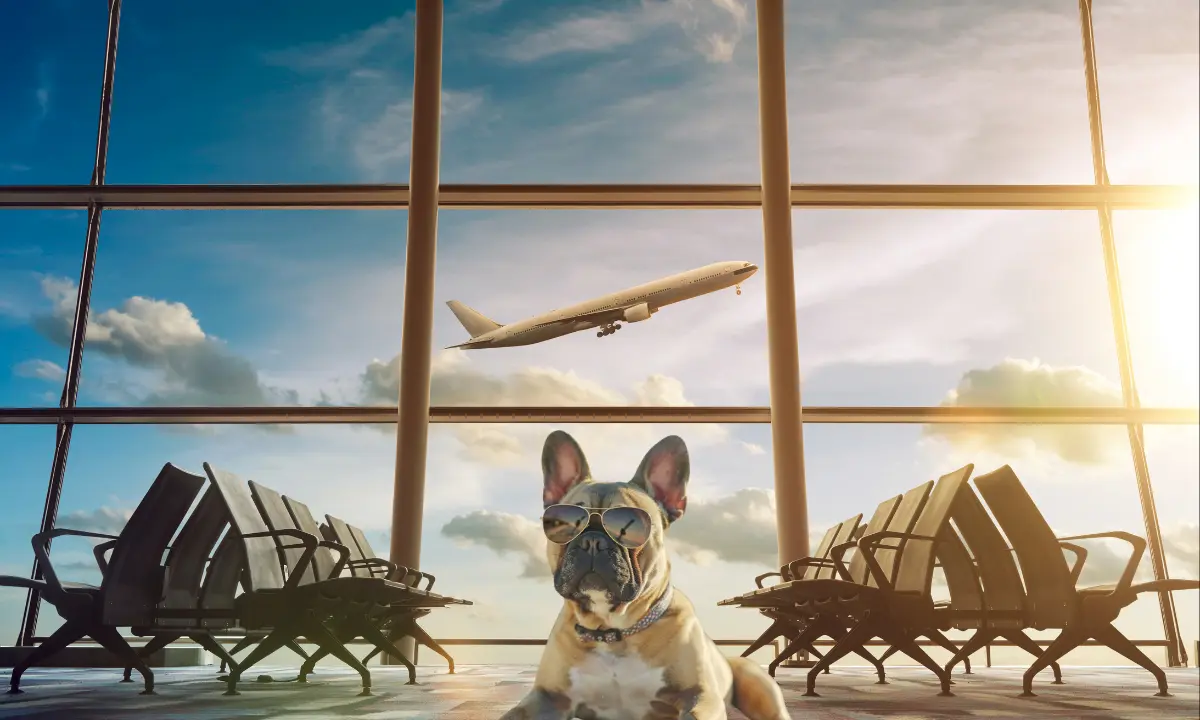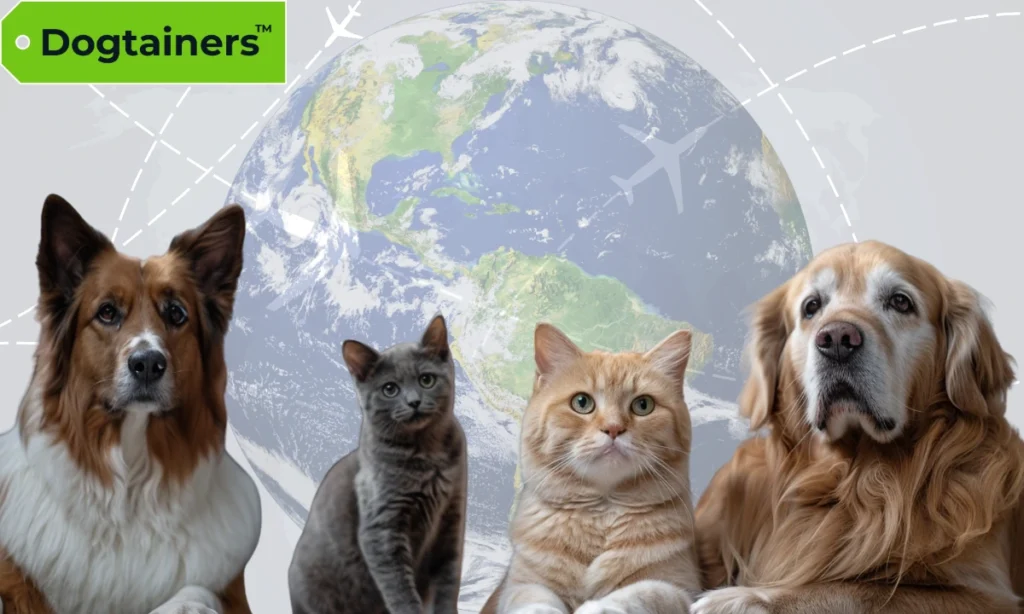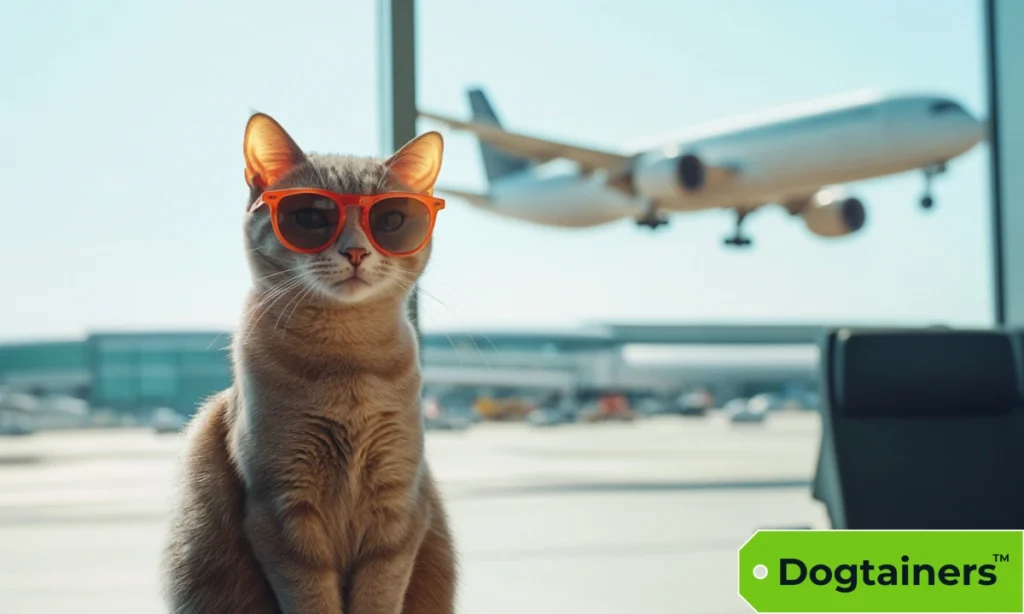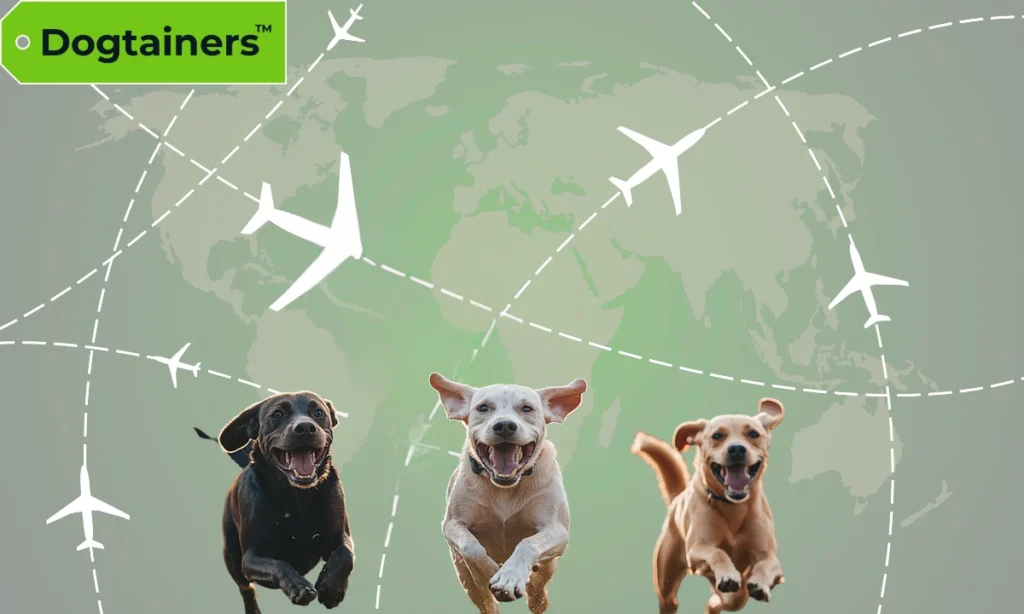Travelling with pets within Australia or internationally takes careful planning and consideration. Many pet owners have anxiety about flying with pets due to the complexities involved.
We’ve seen it all in 50+ years of pet transport. And we’ll answer 13 common questions about flying with pets.
Hopefully, our answers will calm your anxiety about travelling with your pets. Let’s take off.
1. Where do pets go on planes?
Currently, pets travel in the cargo hold in Australia – usually at the rear of the plane. This compartment is pressurised, like the one you fly in.
The captain generally sets the temperature at a comfortable 18ºC. This area is dimly lit, so your pet will be comfortable and can doze off easily during the flight.
Your pet has a separate area in the cargo hold, away from bags. This ensures the safety of your pet. The pet carrier also gets secured, so it doesn’t move during the flight.
Flying with pets in the cargo hold is the standard practice across Australian airlines. This area is safe for pet travel, and we must follow strict IATA protocols when flying pets.
2. Which airlines allow pets in the cabin in Australia?
Currently, no airline allows pets in the cabin in Australia. Service dogs are the only exception to animals being allowed in the cabin on planes.
But the landscape for flying with pets in the cabin on Australian airlines is changing. Virgin Australia is actively working to allow pets to fly in the cabin.
The popular airline plans to introduce this service on select domestic routes within a year. Pets allowed to fly in the cabin will be limited to small cats and dogs. These must remain in approved pet carriers under the seat in front of their owners during the flight.
Virgin Australia’s move could set a new trend for pet travel within Australia. It aligns with practices in other parts of the world where pets are often allowed in the cabin. The change reflects a growing demand among passengers wishing to travel with their pets in the cabin.
3. What documentation do I need for international pet travel?
Although it varies by country, generally you need several vital documents for international pet travel. These ensure your pet meets the entry requirements of the destination country and complies with airline regulations.
Microchip
Your pet must have an ISO-compliant microchip. This is crucial as the microchip number must be included in all documentation.
Vaccinations
Pets need up-to-date vaccinations. These depend on the destination country but commonly include rabies, distemper, hepatitis, parvovirus, and others. Pets from certain countries may need additional vaccinations like those for canine influenza.
Health Certificate
A health certificate issued by an approved vet. This should confirm your pet is free from infectious diseases and fit for travel.
Rabies Titre Test (RNATT)
You need an RNATT to show sufficient rabies antibodies (confirm that the rabies vaccination offers protection). New Zealand, Norfolk Island, and Cocos (Keeling) Island are the only exceptions when bringing pets into Australia. The test should be done within a suitable period before travel, and the results must be included with your travel documents.
Internal and External Parasite Treatment
Treatments for internal and external parasites must be administered within specific timeframes before departure. This usually involves at least two treatments for internal parasites and regular treatments for external parasites like fleas and ticks leading up to the travel date.
Import Permit and Export Paperwork
You may need to apply for an import permit, depending on your destination country. This permit usually requires details about the pet’s health, vaccinations and treatments. RNATT results and other relevant medical records should accompany the application.
Quarantine Arrangements
Some countries require pets to undergo quarantine upon arrival. You must arrange this in advance and have confirmation of the quarantine booking before travel. The length of quarantine and specific requirements can vary widely depending on the country.
Each country has different regulations and requirements. A professional pet transport company like Dogtainers can assist with the complex logistics of international pet travel.
4. Does my pet need a health check before flying?
Your pet needs a health check before flying to Australia. This is a crucial step to ensure your pet meets Australia’s stringent import requirements and to verify that it’s fit to travel.
Your pet needs a health check and an accompanying health certificate. An approved vet must issue the certificate, proving your pet is free from disease and fit to travel.
Your pet may need a health certificate if you’re flying to another country from Australia. This depends on the arrival country, but we always recommend getting a pet health check when flying internationally.
Your pet usually won’t need a health check when flying domestically. Exceptions are:
- Pets aged 8-12 weeks
- Older pets over 12 years old
- Snub-nosed breeds like French Bulldogs
- Dogs flying to Tasmania – treatment for hydatids
5. Is flying safe for pets?
Yes, flying is safe for pets. Rest assured, your pets can fly safely – especially with a company like ours that must follow the strict protocols laid out by the IATA in the Live Animals Regulations manual. We adhere to travel crate specifications and airport and airline restrictions, ensuring safe travelling conditions.
Dogs, cats, reptiles, rabbits, birds and even fish travel well without adverse side effects.
Pets travel in the cargo hold, usually at the rear of the plane.
- This area is pressurised – just like the one you fly in.
- The captain sets the temperature at a comfortable 18ºC.
- The area is dimly lit as well – so your pet will be comfortable.
- Your pet has a separate area in the compartment, away from bags.
Flying is safe for pets. We’ve been flying pets safely for 50+ years.
6. Should I sedate my pet before flying?
We strongly advise against sedating pets before flying. Under sedation, your pet can become:
- Dehydrated
- Disorentiated
- Travel sick easily
Generally, aircraft personnel check your pet’s welfare when loading them onto a plane. If they notice the animal seems sedated or unresponsive, they’ll remove it from the aircraft.
Authorities also have a harder time assessing your pet’s health on arrival if it’s sedated. We advise against sedation for even the most anxious pets.
We recommend looking at products that remove anxiety and stay away from sedation completely.
7. Can all breeds of dogs and cats fly?
Not all breeds of dogs and cats can fly. For instance, some brachycephalic or “snub-nosed” dog breeds have problems with flying.
They’re more sensitive to air quality and temperature changes in the cabin. So, some airlines won’t fly these breeds.
Some common brachycephalic breeds are:
- King Charles Spaniel
- French Bulldog
- Pekingese
- Shih Tzu
- Boxer
- Pug
- Persian Cat
The dog and cat breed also impacts flying with pets into Australia from other countries. You can’t fly into Australia with the following dog or cat breeds:
Pure Breed Dogs
- Dogo Argentino
- Fila Brasileiro
- Japanese Tosa
- American Pit Bull Terrier or Pit Bull Terrier
- Perro de Presa Canario or Presa Canario
Hybrid Dogs
- Czechoslovakian Wolfdogs (Czechoslovakian Vlcak)
- Saarloos Wolfdog or Saarloos wolfhound
- Lupo Italiano or Italian wolfdog
- Kunming Wolfdog or Kunming dog
Cats:
- Savannah cats: domestic cat (Felis catus) crossed with serval cat (Felis Serval)
- Safari cats: domestic cat crossed with Geoffrey cat (Oncifelis Geoffroyi)
- Chausie cats: domestic cat crossed with Jungle cat (Felis Chaus)
- Bengal cats: domestic cat crossed with Asian leopard cat (Prionailurus Bengalensis)*
*In certain circumstances Bengal cats that are five generations or more removed from their wild ancestor may be imported.
8. Can you take dogs on planes?
You can’t take dogs in the cabin area on planes in Australia. But attitudes to taking small dogs on planes are changing for Virgin Australia.
The airline recently announced plans to let you take small dogs in the cabin on certain domestic flights. This will be an Australia-first service, is subject to regulatory approval, and is expected to launch within 12 months.
Your dog must travel in the cargo area of the plane until then. Service dogs are the only exception to this rule, with all airlines allowing service dogs to travel in the cabin.
9. Can you take cats on planes?
You can’t take cats in the cabin area on planes in Australia. But flying with cats in the cabin is becoming more feasible with recent changes in aviation safety laws.
Recently, Virgin Australia announced plans to allow pets in the cabin on certain domestic flights. This includes small cats.
This policy is expected to be implemented within 12 months, pending regulatory approval.
Other airlines have been slower to adopt cabin travel for cats. For example, Qantas and Jetstar have opted not to allow cats in the cabin.
It remains standard for cats to travel in the cargo area for now. This area is designed to be safe and climate-controlled to ensure the well-being of cats during flights.
10. Can I bring my dog to Australia?
To bring your dog to Australia from overseas, you’ll need to comply with several stringent biosecurity measures:
- Import Permit: Apply for an import permit through the BICON system after ensuring your dog meets all health requirements.
- Vaccinations and Treatments: Ensure your dog is microchipped, vaccinated against rabies, and has passed a Rabies Antibody Titre Test. Your dog also needs treatments for internal and external parasites.
- Health Certificates: Get a health certificate from an approved vet.
- Quarantine: Dogs must undergo a mandatory quarantine upon arrival – unless entering Australia from Group 1 countries New Zealand, Norfolk Island, and Cocos (Keeling) Island. The minimum quarantine period for dogs entering Australia is 10 days. But this can extend to 30 days or more, depending on the circumstances.
Bringing your dog to Australia? Our pet import services take the stress out of the process.
11. Can I bring my pet’s favourite toy on the flight?
It depends on the airline you’re using to fly with pets. Some airlines have a strict no-toys policy, while others welcome small soft toys.
For instance, Qantas states this in their pet booking policy: “One favourite toy can be stowed in their crate if required.”
Hard objects generally aren’t allowed in crates due to safety concerns. These may harm pets during turbulence.
A pet transport company like Dogtainers can advise you on the latest airline policies. We’ll let you know whether or not you can bring your pet’s favourite toy on the flight.
12. How early should I arrive at the airport with my pet?
Arrival time at the airport with your pet depends on whether you travel domestically or internationally. If flying with pets domestically, drop your pet off 90 to 120 minutes before scheduled departure. We recommend dropping off pets no earlier than 120 minutes before departure because the freight team won’t accept pets before 2 hours.
Drop-off times may differ for those flying with pets internationally – we can advise on this before departure.
13. Where do you pick up pets at the airport?
Depending on the airport, pick-up zones vary. These tend to be in the cargo or freight terminal areas, though.
In Australia, your pet travels in the cargo area. So, you generally pick them up at the airline’s cargo facility, not the regular baggage claim area.
Because pets travelling as cargo are handled separately from regular luggage. This ensures their safety and complies with different regulatory requirements.
Pets must be picked up between 10 to 90 minutes after their flight arrives. This can vary depending on the airline and location.
Conclusion
Touch down! Your 13 common questions about flying with pets have been answered.
We hope you’re less stressed out about the prospect of flying with your beloved pets. The process can be smooth soaring – with the best pet travel preparation.
Are you planning to fly with pets anytime soon? Did we miss any questions you might have?
Get in touch, and one of our pet transport experts will have all the answers.





Share this article